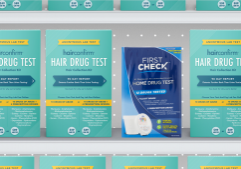Most Commonly Abused Substances and the Dangers That They Bring
Substance abuse continues to plague so many countries and affect so many lives. In the United States alone, it has cost over $750 million, caused several crimes, lowered work productivity, and increased healthcare demands. The damage brought about by commonly abused substances goes beyond a financial perspective – it has also contributed to serious health conditions, and even death to some.
According to the 2015 National Survey on Drug Use and Health (NSDUH), about 21.5 million adults aged 12 and older battle a substance use disorder, and it has continuously escalated each year.
At least 20% of U.S. residents aged 16 and older have experimented with illegal drugs at least once in their lifetime. Marijuana remains to be the most abused substance, with its rate of use increasing after several states have legalized the use of the drug.
Most Commonly Abused Drugs
In reality, there are countless illicit substances that are being sold in the streets or online. Some of these are manufactured by covert laboratories that have mushroomed all over the world. Some of the substances are packed to deceive authorities from identifying them immediately, which is why some drugs carry several street names to avoid being caught.
Here are some of the most commonly abused substances:
Marijuana / Cannabis
Marijuana continues to be the most commonly abused illicit substance. Its status has somewhat changed due to several states legalizing its use as a means of alleviating the pain being experienced by cancer patients. Legalizing it for medical purposes may have become helpful, but it has also increased the chances of others to abuse the said substance.
Knowing its effects has become very much appealing to others. Being able to have a euphoric and relaxing feeling has attracted some individuals to use marijuana recreationally without much thought on its long-term effects on their body.
Effects of marijuana use include the following:
- Addiction
- Altered time perception
- Antisocial behavior including stealing money or lying
- Anxiety
- Decline in IQ (which can be more serious on individuals who started at a young age)
- Distrust
- Fear
- Financial difficulties
- Greater chances of being unemployed or not getting good jobs
- Impaired thinking and ability to learn and perform complex tasks
- Increased appetite
- Increased sensory perception
- Increased welfare dependence
- Laughing trip
- Lower life satisfaction
- Panic
- Paranoia
- Poor school performance and higher chance of dropping out
- Potential development of opiate abuse
- Psychosis
- Relationship problems, intimate partner violence
Synthetic Marijuana (K-2 / Spice)
Synthetic marijuana is also known as K-2, Spice, fake pot or synthetic cannabis. These are actually made up of a mixture of dried plant and chopped herbs, which are sprayed with synthetic cannabinoids. Aside from the mentioned names of K-2, it is also popularly called in the streets as Mojo, Black Mamba, and Scooby Snax.
When these dried plants and herbs are mixed, they may not pose any harm. However, adding synthetic cannabinoids may cause an alarming effect on the individual who uses it. Individuals are inclined to use such substance since marijuana use is illegal in some U.S. states.
Thinking that using K-2 would also be a great way of experiencing the same effect as using marijuana, some individuals opt to use this, as it may cost less than real marijuana.
K-2 was then freely sold in the market thinking that it was a harmless substance. It is often sold as potpourri, room deodorizer or ionizer and is marked as “not for human consumption” to avoid suspicion by authorities.
Users may experience dangerous side effects from using synthetic marijuana such as:
- Confusion
- Extreme agitation
- Hallucinations
- Heart attack
- Intense anxiety
- Intense anxiety
- Intense cravings
- Kidney damage
- Lethargy
- Paranoia
- Psychotic episodes
- Psychotic symptoms
- Seizures
- Vomiting
Alcohol
Alcohol may not be an illegal substance, but absence of any control may lead to addiction. People are more likely to take alcohol as their means of having a great time with friends.
To drink within controllable amounts may not cause too much harm in their body. However, taking too much too often may cause serious damage to one’s health, and endanger the lives of others.
Most DUI reports were related to alcohol use beyond the allowable amount. Alcohol abuse has caused numerous road accidents that have claimed the lives of others as well.
Alcohol is a very popular choice among teens and young adults as their way of their escape and form or relaxation.
Long-term use of alcohol has some serious side effects, which include:
- Abortion
- Alzheimer’s disease and other dementias
- Cancers (breast, colorectum, esophagus, larynx, liver, mouth, and pharynx)
- Cardiomyopathy
- Depression
- Diabetes
- Esophageal varices (mostly due to liver cirrhosis)
- Gallbladder and bile duct disease
- Heart failure
- Ischemic heart disease
- Preterm birth complications
- Stroke
MDMA
This “club drug” is a popular stimulant that is distributed during parties and musical events. It is widely known as Ecstasy or Molly. It is currently classified under Schedule I of the Drug Enforcement Agency’s Controlled Substances Act. It has no proven medical use in the United States and may cause physical and psychological dependence. Its effects are similar to that of amphetamines.
It is sold in the form of a pill, capsule or tablet in different colors, and may sometimes have cartoon images printed on them. Molly mostly refers to the molecular crystalline powder form of MDMA, which are sold in capsules.
The drug’s effect may be felt 15 minutes after it has been taken. The person will experience a different kind of sensation, making him less inhibitive and more frequent mood swings.
Taking this drug may lead to the following symptoms, namely:
- Blurred vision
- Chills or sweating
- Faintness
- Higher body temperature (can lead to serious heart, liver, or kidney problems)
- Increased risk for unsafe sex
- Increases in heart rate and blood pressure
- Muscle tension
- Nausea (feeling sick) and possible vomiting
- Teeth clenching
Tobacco
Tobacco is a regulated substance. Taking too much of it, most especially among younger individuals, may pose some serious health risks.
Children as young as 10 years old may start using tobacco. Many of them are mainly influenced by either their parents who are smoking tobacco or their favorite celebrities. Being in the stage of being curious and wanting to feel a certain amount of freedom, teenagers are likely to use tobacco especially when they are with their peers.
In some instances, some teens get hooked on this substance because they are being forced by their friends so that they can “belong” to the group. Unfortunately, individuals who start using tobacco at a young age are at a higher risk of using alcohol and other illegal substances.
Long-term use of tobacco may lead to several health conditions, which include:
- Cancer
- Chronic Obstructive Pulmonary Disease
- Emphysema
- Heart Attack
- Impaired Immune System
- Lung Cancer
- Stroke
Some individuals have turned to using e-cigarettes saying that they are not as harmful or may not be harmful compared to real tobacco. However, studies have shown that about 80% of the chemicals used in e-cigarettes are actually carcinogenic.
Smoking tobacco does not only harm the person smoking it, but can similarly have a huge impact on the health of the people that surround them through secondhand smoke.
Long-term use of tobacco may shorten the lifespan of an individual by 20 years.
Prescription Opioids
Prescription opioids are semi-synthetic medications that are prescribed to relieve various levels of pain. These drugs have the ability to reduce the intensity of pain signals, and are capable of producing a positive effect on the user. Because of the positive feeling that opioids can do to the user, prescription painkillers have become one of the favorite recreational substances by some individuals.
Experiencing a euphoric feeling may be too strong, to the point that it makes the user feel more carefree and forget their problems.
However, tolerance to the drug is likely to happen. Once a user gets used to the same dose, he would no longer feel the same effect. He will then tend to take in more until he reaches the desired effect. Doing this for a long time may pose some health hazards such as:
- Abdominal distention and bloating
- Brain damage due to hypoxia, resulting from respiratory depression
- Constipation
- Dependence
- Development of tolerance
- Liver damage (especially prevalent in abuse of drugs that combine opiates with acetaminophen)
- Nausea and vomiting
Steroids
Steroids are generally life-saving substances (such as corticosteroids) used to improve the breathing of an individual who may have difficulty in normal lung functionality. However, there is another type of steroids abused by athletes and bodybuilders, and it’s called anabolic steroids.
Some sports professionals use steroids to help them decrease body fat, gain muscle mass, increase their strength, and improve overall performance. This type of steroid is considered illegal since it can bring serious health damage to individuals, most especially if used for a long time.
Side effects from anabolic steroid use can lead to the following medical issues in men:
- Reduced sperm count
- Shrinkage of the testicles
- Infertility
- Enlarged the breasts
In women, anabolic steroids may cause:
- Decreased breast size
- Deepening of the voice
- Enlarged clitoris
- Increased body hair
- Rough skin
Generally, anabolic steroids may cause any of the following:
- High blood pressure, heart attack, or stroke.
- Higher levels of bad cholesterol (LDL) and lower levels of good cholesterol (HDL).
- Irritability, rage, aggression, violence, uncontrolled high energy (mania), false beliefs (delusions), and addiction.
- Liver disease and possibly liver cancer. The chance of these problems is higher when steroids are taken as a pill.
- Oily skin, acne, and male-pattern hair loss.
- Skin infections that can become severe if the drug was tainted with bacteria.
Withdrawal
Any individual with a substance abuse problem and submits himself for rehabilitation is likely to experience painful withdrawal symptoms. To help him to completely recover from the addiction, he needs to be in a facility under close medical supervision.
Due to the difficulties that they go through in the recovery process, some individuals have chosen to leave the facility. This may lead some of them to get hooked back to the same substance.
Treatment for Substance Abuse
Some substance abuse treatment options may need another kind of drug to counteract the effects of withdrawal symptoms, such as naloxone. Meanwhile, other types of substance abuse merely need to slowly take away the drug from the individual’s system until he gets used to not having any of the substance at all.
After detoxification, as part of the rehabilitation, there is a need to undergo psychotherapy. This will help the individual to properly address whatever has caused the addiction.
The most common reason why individuals turn to such addiction is when they feel that they are left alone and that there is no one there to listen to them. It will be helpful for the complete recovery of the individual that the family gets involved. This will allow the recovering addict to feel that he is being accepted back by family and friends, making it easier to get back to his normal life.
Fighting any substance abuse issue should start within the family. It is important that parents should be able to discuss with their children the dangers of abusing such substances. This way, kids will have an increased awareness of what these substances can do to them.
Parents have a huge responsibility to their family. It is not enough to give them all they need. Sometimes, they tend to forget the most important thing that any child would want: having quality time with the family and feeling loved.
Support
Ordering
About Us
Connect
Confirm BioSciences.
© 2019 Confirm BioSciences, Inc.
All Rights Reserved. See our Terms & Conditions and Private Policy.



